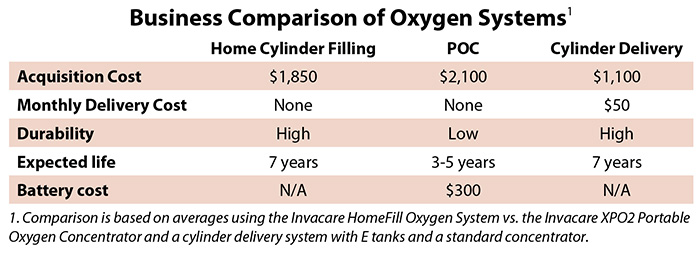Round 1 of National Competitive Bidding (NCB) saw an average oxygen reimbursement reduction of 33 percent. As round 2 of NCB is implemented in 91 new cities next year, you can expect to see further reductions. The costs of gasoline, driver pay and other delivery requirements continue to rise. In this challenging business environment, it is critical that home oxygen providers choose cost-efficient oxygen systems that still meet their patients’ needs.
There are a number of different oxygen systems available for ambulatory long-term oxygen patients. Home cylinder filling systems such as the Invacare HomeFill Oxygen System, portable oxygen concentrators (POCs) and traditional cylinder delivery are all options for servicing oxygen patients. The system you choose depends on your business model and treatment goals. The HomeFill system and others like it are the most cost effective, patient friendly options on the market today.
With any business choice, there are advantages and disadvantages to every decision, and the choice of an oxygen system is no exception. The main business advantage of a home filling system compared to traditional cylinder delivery is the elimination of routine delivery costs and thus increased profit for the oxygen provider. The main disadvantage, and the reason many providers have avoided this move, is the upfront purchasing cost.
When comparing a home cylinder filling system and portable oxygen concentrators, the biggest considerations are durability, expected useful life and the cost of replacement batteries. With a HomeFill system, the patient leaves home with an aluminum cylinder while the oxygen compressor stays at home. Thus only the cylinder gets exposed to the elements, dropped and otherwise experiences normal wear and tear while the more expensive compressor stays behind. When using a POC, the oxygen concentrator itself gets taken from the home and is subject to possible damage.
Despite recent advances in battery technology, no battery lasts forever. Portable oxgyen concentrators require battery replacement every two to three years at a cost of about $300 each time. Because a home filling system doesn’t use batteries, it is not subject to this extra, nonreimbursed cost.
From a patient’s perspective there are many advantages and some disadvantages to using a home cylinder filling system versus cylinder delivery or portable oxgyen concentrators. An oxygen patient’s biggest fear is running out of oxygen. Because a patient with a HomeFill system fills their own cylinders, they never have to worry about running out of oxygen. This encourages patients to ambulate more and be compliant with their prescribed oxygen therapy regimen.

Patients also prefer the advantage of being able to use smaller, lighter cylinders when ambulating. Most POCs weigh over 6 pounds with some of the continuous flow units weighing about 20 pounds. Even an E tank weighs more than 10 pounds and requires the patient to carry the cylinder with a cart. Using a cylinder filled at home not only makes it easier for the patient to carry the cylinder but has the added benefit of encouraging ambulation.
We’ve established that a home cylinder filling system is more cost effective for providers and preferred by many patients, so how does the system itself work? A HomeFill compressor takes excess oxygen produced by the oxgyen concentrator and compresses it into an ambulatory cylinder. Patients can continue breathing from their concentator during the filling process as long as their prescription is 3 lpm or less (5 lpm if using a 10L concentrator). The compressor shuts itself down when the cylinder is full so there is no need for the patient to monitor the progress of the fill. With an easy cylinder connection and only one button to push, the system is simple and user friendly.
Providers who want to maximize their profitability using a nondelivery oxygen system should focus on three things. First, put the systems you’ve bought into the field, don’t wait for the “perfect” patient. They aren’t keeping you profitable sitting on the shelf. Second, incentivize your staff to use the systems and make sure everyone in your organization knows why you’re doing it and how important it is. Finally, tell your referral sources what you’re doing and sell them on the idea. It is important that your referring physicians understand the oxygen system you are giving their patients and why it is better for the patient.

Choosing the right oxygen system for your business and your patients isn’t always easy. No single oxygen system is going to be ideal for every patient; however, a cylinder filling system will be the best option for a substantial portion of your patients. When choosing oxygen systems for your patients, match their needs with the capabilities and strengths of the various systems available.
